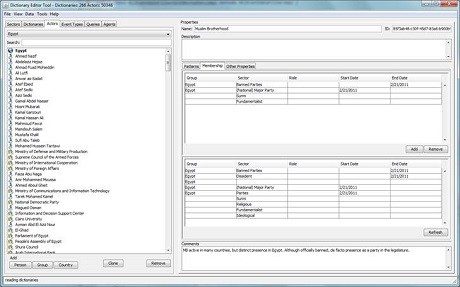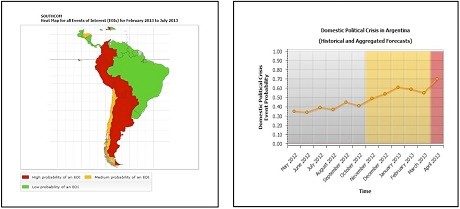Integrated Crisis Early Warning System (ICEWS)
The Integrated Crisis Early Warning System (ICEWS) program is a comprehensive, integrated, automated, generalizable, and validated system to monitor, assess, and forecast national, sub-national, and internal crises. ICEWS supports decisions on how to allocate resources to mitigate crisis. Using ICEWS, Combatant Commanders (COCOMs) have a powerful capability to anticipate and respond to stability challenges, allocate resources in accordance to the risks they are designed to mitigate, and track and measure in real time the effectiveness of resource allocations toward end-state stability objectives.
ICEWS uses a mixed methods approach to instability forecasting, combining heterogeneous statistical and agent-based models in an integration framework with an aggregate forecast accuracy of more than 80 percent. These models are provisioned in near real-time from more than 100 data sources and 250 international and regional newsfeeds. Millions of news stories are processed by an innovative, shallow-parsing Jabari technology and BBN’s Serif NLP technology. The results are presented in an interactive, customizable web-based portal featuring time series, map-based and other views. Model forecasts are presented through a variety of visualizations supporting drilldown to foster trust in models through transparency.

Key Features and Benefits of ICEWS
iDATA
iTRACE
iCAST
iSENT
iDATA
The iDATA repository contains over 45 million world-wide stories in English, Spanish, Portuguese and Arabic, spanning from January 1991. These unclassified stories are obtained through both Factiva as well as the government Open Source Enterprise (formerly Open Source Center) and are processed through innovative deep and shallow-parsing technologies to produce a set of over 25 million unique geolocated events with an accuracy of greater than 80 percent. This event data consists of date-stamped and geolocated event triples that recount who did-what to whom.
There are over 300 different types of coded events drawn from the Conflict and Mediation Event Observations taxonomy, with each event type having an observer-neutral intensity score that represents how hostile or how cooperative the event is. The actors (country, sector, organization, individual) involved in events come from dictionaries of over 50,000 named and time-indexed entities as well as over 700 generic agents (e.g. police, government official, protestor).
iDATA provides the underlying data that is leveraged by the iTRACE (trending) and iCAST (forecasting) components of the ICEWS system. The iDATA repository is one of the largest human socio-cultural data sets that has unified data that can be exploited by both operators and social science modelers.
You can find ICEWS data on the Harvard Dataverse.

Key Features and Benefits
25+ year unified set of human social cultural data
Event data describing who did what to whom, when, and where
State data set of 30 sources unified for analysis and processing

iTRACE
ICEWS Trending, Recognition, and Assessment of Current Events (iTRACE).
iTRACE provides a fully automated capability to monitor political activity around the globe by automatically converting news reports into structured indices that reflect the character and intensity of interactions between key leaders, organizations, and countries—who is doing what to whom, when, where and how around the world. Users from various military, government, and intelligence communities are using iTRACE to create analytical products.
Using a variety of text analytics tools, iTRACE automatically ingests and processes news stories (currently more than 45 million since 1991) from a variety of international, regional, national, and local news sources (currently more than 6000) to build a database of coded event data. This data then drives dynamic operator displays showing recent trends in events by type, participants (countries, groups, and individuals), intensity, etc. The operators are able to view the data in graph, timeline and map views to aid in situation understanding and tracking. Operators are able to drill down into the underlying data within iTRACE to include the original news stories. Other capabilities such as the Event Browser allow unparalleled access to the event data that allows the data to be filtered, sliced and diced, and presented as desired.

Key Features and Benefits
Operators view events in graphs, timelines, and maps
Drill-down is available to the underlying news stories
Operators can quickly understand what is happening in a country or region and warns them of instability precursors
Views allow analysis of the AOR as a whole, region or country

iCAST
iCAST provides the capability to forecast instability events around the globe using a mixed methods modeling approach that combines forecasts from heterogeneous statistical and agent-based models to generate an forecast with accuracy of greater than 90%. Through transparency views, the user can drill-down into the underlying model variables and data to gain trust in the forecasts for themselves and experiment with the effects of changes on the model indicators in a “what-if” manner.
iCAST provides 6 month rolling forecasts for destabilizing Events of Interest (EOI) for 167 countries around the world. Operators can view aggregate forecasts for each country generated from over 80 heterogeneous integrated models for five EOIs (Domestic Political Crisis, International Crisis, Ethnic/Religious Violence, Insurgency, and Rebellion). These forecasts are coalesced from the weighted forecasts of various models to create a forecast shown to be superior to any single modeling method. Operator can drill-down into the forecast as well as into each individual model that contributed to the aggregate forecast.

Key Features and Benefits
Operators view rolling 6 month forecasts for the world in charts and maps to assess the stability of each country
Drill-down capabilities exist from the aggregate model into each individual model’s variables and associated data
Operators can perform what-if scenarios on the individual models for analysis purposes

iSENT
The amount of Open Source digital content being generated during uprisings and riots around the world are creating a massive and immensely valuable source of data. iSENT gives intelligence analysts the tools to understand the latest regional trends and sentiment, predict threats from groups and individuals or find the proverbial “needle in a haystack”. Exploiting social media as an intelligence source requires high-performance analysis algorithms that can rapidly distinguish between high-value information and noise among massive and rapidly changing content.
iSENT delivers an automated aggregation of publicly available data sources. It provides data management and display of data, including advanced filtering and tagging for on-the-fly processing of data subsets. iSENT creates temporal and frequency driven visualizations, including analytic trending, sentiment volumetrics, and geographic mapping. Its network analysis and visualizations including web community discovery, directional information propagation mapping, and quantitative online role calculations.

Key Features and Benefits
Analyst productivity enabler
Improved situational awareness
Scalable and extendable to new sources and customized analytical algorithms

Additional Information:
We're engineering a better tomorrow.
Your individual skills play a critical role in changing the way the world works and helping us develop products that make it a safer place to achieve your goals. Our teams are made up of diverse employees from a wide range of disciplines and backgrounds, working together to tackle complex challenges and push the boundaries of innovation.
Explore our skill areas to find the right opportunity for you.







